The company:
With the Japanese company Air Tight there is a lot to discover which is completely absent in todays High End scene. Product running times of more than thirty years without any MK II or upgraded version of a given amplifier is something we wont find at any other company today. If a piece of gear is developed, than it IS developed, there is no reason for any change, which says something about the quality of the development. Miura San is one of the last living legends in the audio scene, meanwhile in his mid eighties, he has a lifetime of experience in building tubed audio equipment, a sort of deep understanding seldom found in todays fast changing market were every year new completely unknown people want to tell us, they found a new technology in amplifying an audio signal. With some new technologies, like digital amplifiers, that might be true, but with tube technology???
Miura has a sort of calm style in managing his company and developing audio gear. Things need time, countless listening tests, which was very clearly seen with his Opus 1 cartridge, which Air Tight brought out two years ago as a cooperation project between Matsudaira San (My Sonic Lab) and Miura San of Air Tight (A&M ltd.) to celebrate the 30. birthday of the company. Miura needed more than 3 years from the first prototype, shown to the press and some “insiders” for listening tests, till the final product entered the market. And between the first prototype and the final candidate, there was much more different, than just the styling of its beautiful appearance. Instead of that Miura changed a lot of details which had a tremendous impact on the sound of the final product. It is astonishing how a man in his mid eighties could achieve such a good hearing as also spending so much attention to the finest details. The fruit of his restless work was once again, as we witnessed it more than 10 years ago with the legendary PC1 Supreme cartridge, a place at the very top of todays cartridge designs. The portfolio of the small company near Osaka, which counts around 6 employees, is dedicated to the analogue music lover. There are no CD players or DA converters in existence, instead of those kind of products, Miura offers a wide range of tube pre, phono and power amplifiers, which use nearly every single famous power tube concept in existence, as the 300B, 211, EL 34, EL84, 6L6 GC and the KT88. The output power varies between 2X 8 Watts of the ATM300 to 2X 110 Watts of the ATM3 EL 34 monoblocks and is finely graduated. Not only this wide variation of power tube concepts reminds me of one of the other legends in the Japanese art of building tube equipment – …Shindo.
An indication of both companies is the fact, that the price of an amplifier has no direct influence on his sound. The smallest amp Air Tight has in their portfolio, the ATM1s is one of the finest EL 34 amplifiers I know.
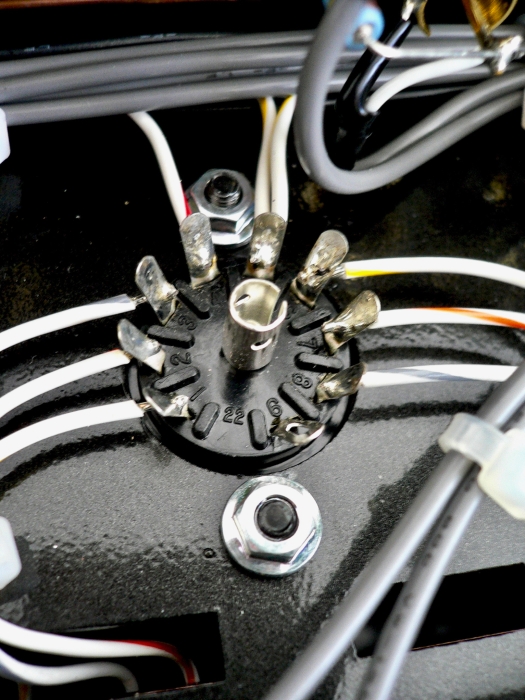
The difference in money you have to spent for the power amplifiers has more to do with the size of transformers (and their price tag) and power supplies, because a KT88 in ultra linear operation with its 2X 75 Watts needs more expensive iron, than an EL 34 amplifier, the exception of this rule concerns all single ended amplifiers. What I want to say is – in the Air Tight amplifier lineup there is no such thing as entry level and reference level in their ability to give you a maximum in soundquality! That said, things change quite a bit with the portfolio of preamplifiers – here we face a difference in fittings, be it the existence or absence of a phono sections, or the kind of outlay in which the gear is made. And even if there is a sort of range describing the quality of the different preamplifiers, there might be also some exceptions from that rule. If the little full function preamp ATC1 is mated with the previously mentioned ATM1s, (a pairing which was made for each other and was also developed together), you are in for a treat!!
The lineup includes pure line stages and full function preamplifiers with on board phono sections, as also stand alone phono preamps. The more basic (which does not mean simple or bad sounding) gear share a transistor, diode rectified power supply, as we climb up the range, we get tube rectifiers and full tube stabilisation with some of the most elaborated hybrid power supplies you will find on the market,
The Air Tight ATE2:

Miura had the Chuzpe as an analogue lover to bring a full function preamplifier to the market, which has a full blown phono section with all bells and whistles – but he equipped the ATE2 just with one single line input. So the ATE2 is not for those audiophiles, who have a tremendous number of gear….just ONE nice FM tuner or CD player, maybe a DAC with switchable inputs (which gains the flexibility if you have more than one digital source) and you are done with the number of line inputs. On the other hand, you will find two MM inputs, switchable from the front plate, and a pair of phono direct outputs, bypassing the whole line stage with all switches, volume control and of course the tubed line gain stage.

This additional pair of output jacks are very special and offer us different operation modes. You can plug the phono direct outputs into your favourite line stage, as you can feed the Air Tight amplifiers directly, because they all (not the ATM300) have two switchable pairs of inputs and sensitivity potentiometers, to adjust the volume or gain. The latter will be the most pure signal flow you can achieve. With its 200 Ohm output impedance the ATE2 has no problems to drive nearly every power amplifier on the market directly. If you have a second amplifier setup in your room, those extra pair of direct phono outputs can also be used to feed a different system, while the whole full function preamplifier resides in his setup, it can distribute the phono signal fully processed (RIAA eq and gain) to another device.
The power supply:
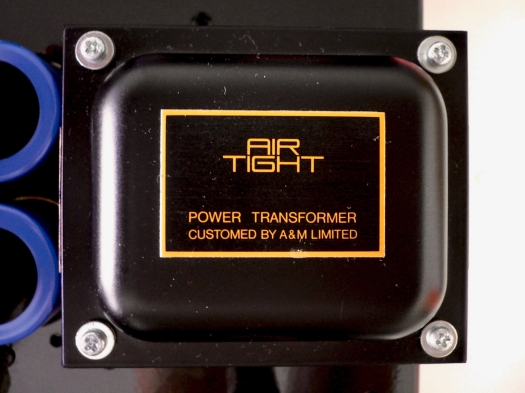
Miura San opted for tube rectifiers and tube stabilisatation in the power supply of the ATE2. Together with the in house produced power tranny with its 8 different outlets, we will find a single 6X4 full wave rectifier tube. Stabilistation is done with a 12BH7 double triode and a EF 86 penthode. The regulation is accomplished fully discrete using the finest components available. Miura replaces electrolytic capacities as fast as possible in favour to high voltage foil caps in the signal chain and supply voltages. Therefor he uses the excellent Audience (Auri Caps). Electrolytics will be found just in the first stage of the power supply and in some regulation circuits, together with ASC paper in oil caps a reminiscence to the golden time of tube technology.

After careful listening sessions, I opted for a GEC CV 4005 black plates in the rectifier stage, which is a British military version of the 6X4 or EZ90 (the European designation for the same tube). The two stabilisation tubes EF 86 and 12BH7 were selected with RCA 12BH7 black Plates foil d getter from the end of the fifties (last century;-)) and the legendary Telefunken EF 806S, which got this status from its use in the well known Neumann U67 microphone.
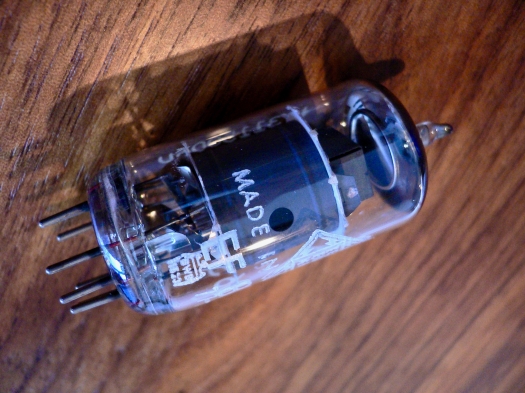
The phonosection:
A novelty in the Air Tight portfolio is the fact, that Miura uses in each of his phono section exactly the same design – what differs is just the expenditure in its layout. The basic design features a 2 stage gain section made with 3X 12AX7 (or ECC83) double triodes. The first gain stage is made with one single 12AX7 which does just gain at this point – subsequently we will find the bass emphasis part of the RIAA curve in the signal flow,
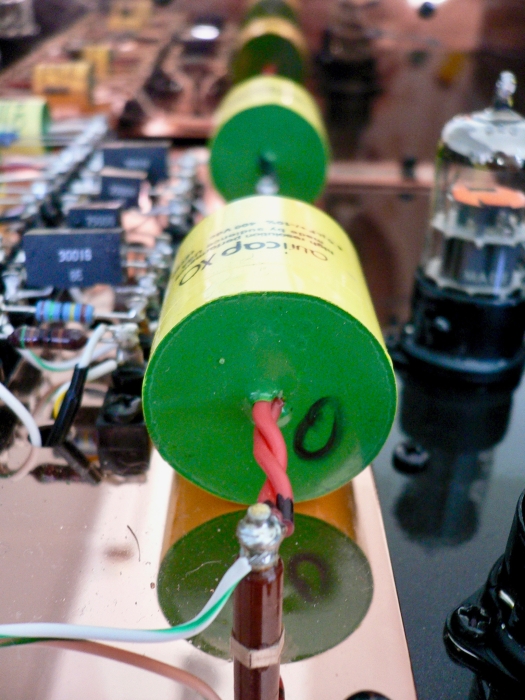
which is located between the first and the second gain stage to avoid noise. The second gain stage uses just one respective section of the two remaining 12AX7 double triodes, after which the signal passes the treble processing of the RIAA curve.The complete equaliser section is made by using a CR circuit, one of the simplest ways to achieve a highly accurate equalisation with a minimum of fuss and parts.

To get a preferably low output impedance Miura designed a SRPP circuit in the decoupling stage of the ATE2 using the two remaining section of the 12AX7 (ECC83). So all in all we have 3 12AX7 (ECC83) in the phono section of all Air Tight preamplifiers with exactly the previously explained implementation. What differs is the kind of execution, the quality of the parts and the power supply. The whole amplifier is point to point wired, which also applies also to the phono section. The whole circuit is placed on a smooth copper plate, which is treated with Zappon lacquer to avoid oxidation. This copper plate has two functions, on the one hand it shields the small signals from electromagnetic pollution, on the other hand it acts as a mechanical isolation device.
The line stage:
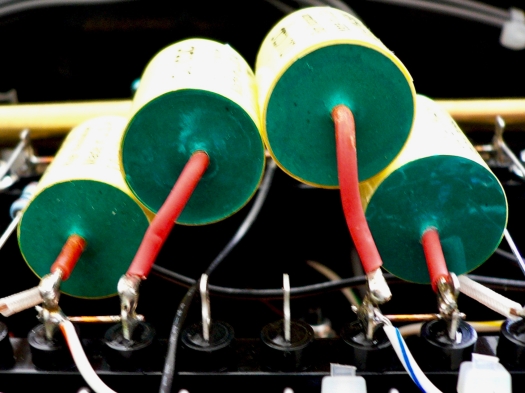
In the line stage of the ATE2 Miura choose ECC88 frame grid tubes . Those are naturally superior to any 12AX7 (ECC83) or 12AU7 (ECC82). With the frame grid technology the Philips group found at the pinnacle of the tube age one of the most dramatic progression in the sound quality of electron tubes. If you have the chance to peek into such a construction, you will understand that this technology signified a whole new chapter in tube design – those tubes are made like a piece of mechanical and electro mechanical art! The ATE2 uses a two stage design in their line section implemented with two ECC88 and decouples the signal with a SRPP design we already discussed with the phono section to achieve also 200 Ohm output impedance.

The volume tracking is accomplished with one of the best possibilities next to a ladder switch, by using the very famous ALPS Japan RK 501 pot….A haptic enjoyment! This thing is extremely transparent and does not ad any coloration to the sound, as it gives you a very precise tool to adjust volume, even in very, very small increments. The stunningly even channel balance of this pot is amazing – even if it does not work in its optimal range – amazing!
Controls:
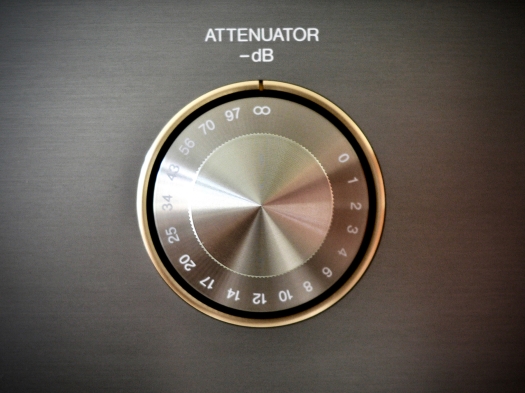
Next to the ALPS RK 501 volume potentiometer, we will find a stereo/mono switch on the front plate of the ATE2, as also balance control and two switches for the different sources. The latter is made in a special way – you have a switch which selects line or phono, and an additional one for selecting one of the two phono MM inputs. All switches are easy maintainable if one day they need some cleaning. Both switches do react without any noise! Last but not least we will find the power button on the right side of the front plate, which is typical for any Air Tight gear. Miura designs every piece of gear with a certain legality, the power supply sections are always at the right side of the gear as it is the power inlet.
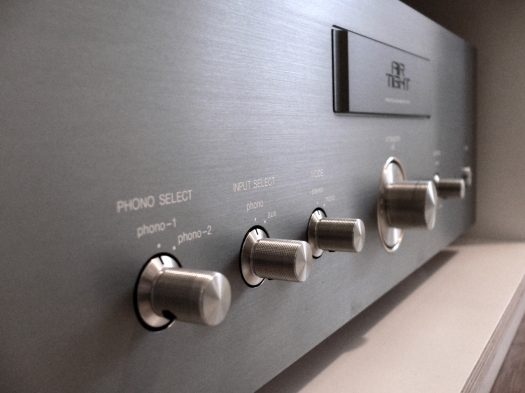
It is very easy to built up an Air Tight system without getting a big mess behind the gear with signal and power cables twisted together – very, well done Mr Miura! The principle of design means also, that we have to place the gear in a certain way – our goal is to get the largest distance between the power supply of our amplifier and the input section of the phono stage – and as the gear is made as it is – it is an easy task.
Tube rolling:
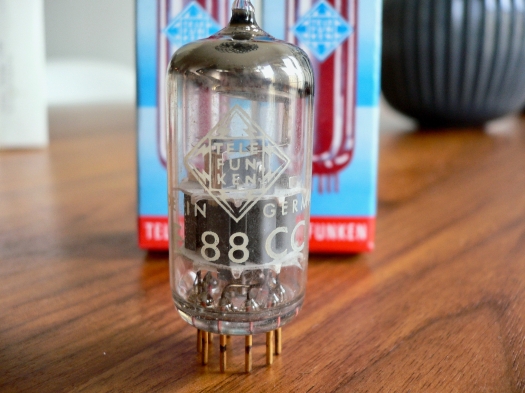
As I use my beloved Quad ESL 57 with the ATE2 it is not recommended to mess up the incredible resolution and pureness of this preamp. So I opted against some very exciting Mullard long plates (MC1 long plates square getter) – because those type of tubes work perfectly with a speaker like the LS3/5a – but not with the restricted amount of highest treble energy the Quad has to offer. The KEF T50 tweeter in the LS3/5a together with the deviding network means a slight treble rise with a tremendous resolution – the T50 is able to react on frequencies over 40Khz with ease. The Quad is a different breed – the treble starts to roll off at 15Khz – and is nearly absent at 18Khz – a Mullard – as beautiful it might sound, is the last thing we need with this speaker system. One might think an Amperex would be a good choice – and yes, I tried this…. I use Amperex long plates 12Au7 and 12AX7 Foil D Getter in another preamplifier in my Quad room – but in this case, i could detect a pronounced emphasis in the prenence, which is typical for the Amperex long plates and one of the reasons for their amazing 3D abilities…. But with this specific preamplifier it was too much of a good thing…
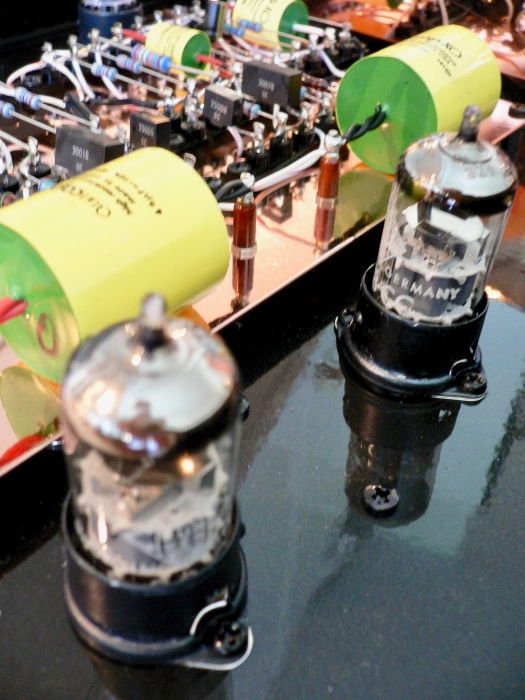
With the decision of proper NOS phono tubes, we also decide what kind of performance we will get regarding the noise coming from the record – all this little nasties like clicks and pops could be amplified in a way, that we will get crazy or we have a lucky smile on our face. There are NOS tubes in existence, which set these noisy signals far away from the music – they perform in such a quick way, that a click is just a short signal, with a Mullard (MC1) in a phono stage, such a click will be a real event, something I cannot live with;-))))
That does not mean, this legendary Mullard is a bad tube – far from it – but in a phono stage ist is everything else than a perfect solution!

As you might guess – I opted for a triplet of equally numbered Telefunken ECC83 smooth plates. A tube which is sooo quiet, one of the most silent ECC83 I know. And the Telefunken can transfer those clicks and pops in something you are able to ignore – a miracle! The ECC83 Telefunken has such a balanced sound, which lets the ESL 57 shine. The bass is tight and well rendered, the mids are outstanding – maybe the reference point in this tube class (read my essay about the Telefunken ECC83 on this blog) – and last but not least we get a high unforced treble resolution, something the Quad needs so urgently! At the whole frequency spectrum the Telefunken is almost neutral – especially in the midband, which is is a MUST, if you listen to a pair of Quad ESL 57 – this little divas are able to show you the slightest amount of coloration.

With the line tubes it was not such a clear decision, and even today, I can live with more than the single solution I finally choosed. I had some of the finest ECC88 to play with, and every single one of them has such a tremendous sound quality with some special colours, the others miss. My stash included Siemens Halske CCA, Telefunken E88CC, Amperex Bugle Boy 6922 Gold Pins and Valvo Red Label E88CC. The Siemens had the finest resolution and the tightest bass – the air this tube can deliver is outstanding, the whole amplifier starts to breathe – amazing! – But the Siemens has a slight defensive midband section, a little bit of the classic HiFi coloration. That is easy, if you listen to Jazz or Vocals as also Pop music – but if you choose one day a very good classic recording – you will detect what I mean. It is still acceptable if you listen to small orchestra music – but if you choose romantic music, like Mahler or Bruckner – it does not work…..massed strings get a synthetic touch, the overtone spectrum sounds not natural anymore….
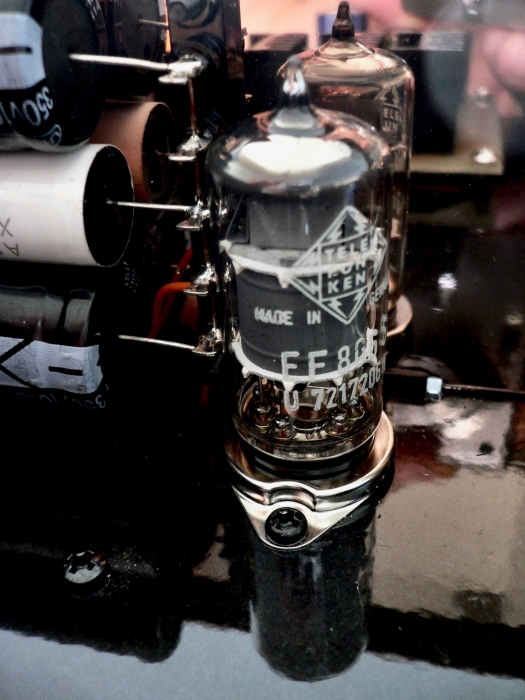
The Amperex has an amazing 3D rendering – it is one of the rare tubes which can tell you something about the third dimension in a given recording – you will get a real nice picture! BUT – the Amperex is also coloured – here it is the presence area of the spectrum. This makes vocals super sexy – female singers are a sort of an erotic experience – but than you listen to some distorted guitars – and it is all over….;-)))) – The presence emphasis transfers a Metallica record to more or less something we would call noise…..yes I hear you – you think IT IS NOISE – but It is not….The guitar sound produced on this specific album is like jumping in a warm swimming pool…. It is arranged in a style comparable with a church organ – listen carefully, and you might detect this album is far from being just noise – even it is Heavy Metal!!!!!!
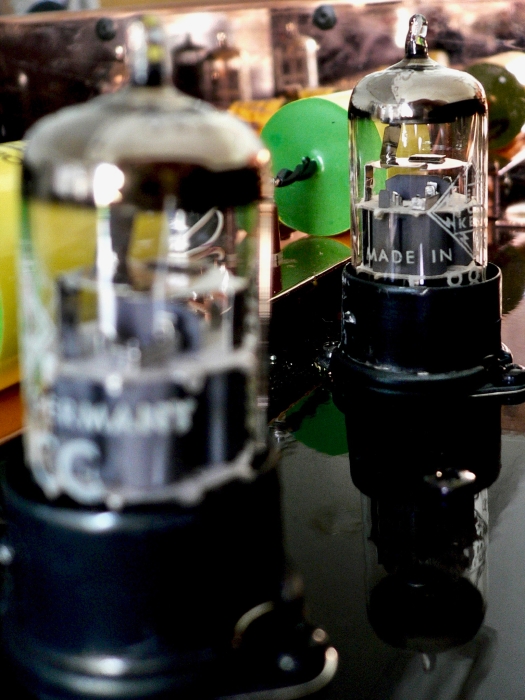
The Valvo Red was amazing – as was the Telefunken E88CC – both are maybe my favourite E88CC in THIS PARTICULAR preamplifier..both share a neutral midband, both have a natural unforced resolution, the Valvo Red being a little bit recessed in rendering the highest frequencies – but not in a way, that I missed something. The Telefunken was more open, and acted quicker at the leading edge. In opposite the Valvo had a slightly more impressive bass…..if I am bored – I can change those two E88CC tubes back and forth – one month is Valvo month – followed by a Telefunken month….I started with the Telefunken E88CC!
The enclosure:
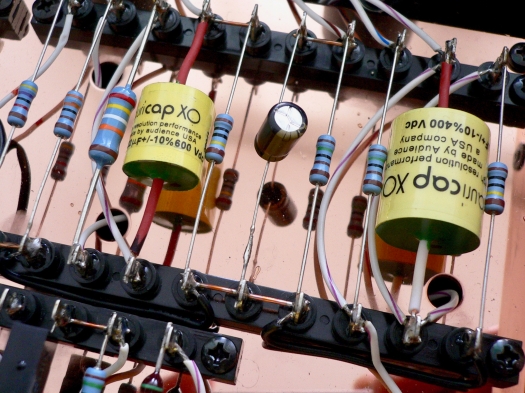
Miura San built his gear like it was made in the golden age of tube amplifiers. There is no cheap aluminium box screwed together, instead he uses a steel enclosure of 1.3 – 1,6mm thickness welded together! After that procedere the chassis gets some solid layers of automobile paint in a baked finish. The reason for such a tremendous outlay is on one hand the perfect shielding such a faraday cage is able to accomplish, on the other hand we will detect that steel is a fantastic resonance absorber. The aluminium frontplate is just screwed on top of the steel enclosure to get a nice an stylish appearance.

The bottom of the ATE2 is made of copper – that means that gear which stands underneath the ATE2 cannot radiate electromagnetic pollution into the fragile circuits. The whole preamp enclosure is divided into 3 main sections. One section is reserved for the power supply and separates the top deck of the ATE2 in two section using a massive copper plate. If we turn the ATE2 over, we will find the bottom main deck, in which the complete line section is located.
The Sound:

I own from Air Tight also the ATE 2005 stand alone phono stage, which uses the same circuit and layout as the ATE2 in its phono section. They both just differ in their power supply (and a very special MC head amp the ATE2005 features). Were the ATE 2005 uses a transistor power supply and diode rectification, as also full discrete transistor regulation, the ATE2 uses a full tubed power department.
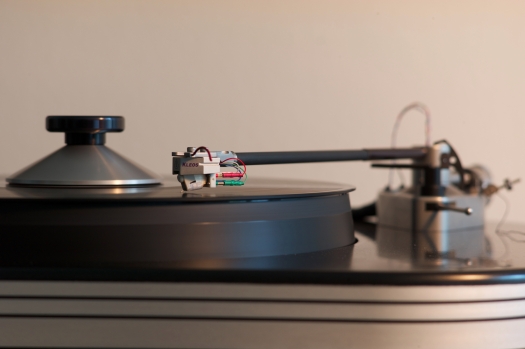
Both differ also in their gain layout, a consequence of the built in MC head amp in the ATE 2005…(another story…)
The ATE2 features 36db of MM phono gain, the ATE 2005 just 30db. For any comparison I had to adjust the volume accordingly – which I did. The impact of tubes in a well built power supply is clearly detectable – the ATE 2005 has a drier bass response, very tight and limitless, while the ATE2 brings a certain agility on the table with an aesthetic which is completely different from the ATE 2005. On Dancefloor, Electronic and some Pop music pieces I like this tight, deep and impactful behaviour of the ATE 2005 very much. If we change the music style to Classic or Jazz, the ATE2 sounds more real, the bass ist more articulate, even if it is not as tight. The music beginnst to breathe, there is a sort of beauty in the bass rendering, which the transistor power supply equipped ATE 2005 cannot counter. On the other hand the ATE 2005 has a sort of openess, which the ATE2 can not muster. The Air and resolution is astonishing – while the ATE2 reacts in a smoother warmer style! Both are some of the finest tubed phono stages in existence today – and both are everything else than equal!
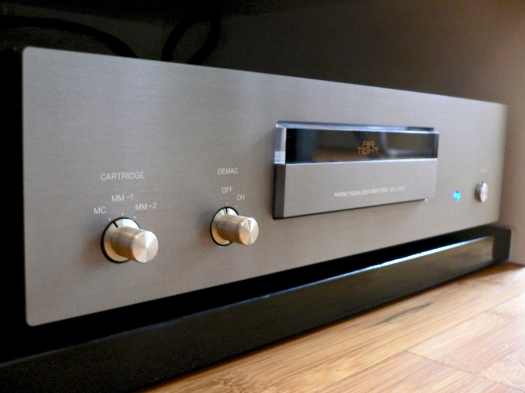
The ATE2 os able to render a jet black background, the micro dynamic abilities are stunning, even the slightest shades of dynamic contrast is presented in all its glory, which is also a form of resolution, nobody speaks about today….but it is a very important type of resolution. Treble and Air resolution, which we get in spades since a couple of yers even if the whole picture drifts into analytic insignificance is one part of the story – but what makes you sit and listen while forgetting to breathe are the finest differences in dynamic shades…I could (and do) waive the last ounce of treble and air resolution with my choice of speaker (the ESL57) but I cannot live without the finest dynamic shades – which brings – in my opinion – music to life. The ATE2 shows this ability with tremendous realism, and the ESL can transduce the whole picture in all its complexity in a very accurate way.
This preamplifier reacts very, very fast to the leading edge of a sound or instrument, and all the Quad lovers will agree, this is one of the skills were our beloved “vintage” speaker shows to most of all modern designs what attack speed is all about. You can witness the birth of a tone – what could be more beautiful….???
It is stunning what Peter Walker designed sixty years ago, which we can enjoy in all its beauty and perfection with todays elaborated moving coil transducers and high resolution (in a good way) electronics. It reminds me of an old Leica screw mount camera with its famous Elmar 1:3.5 mated with a modern black and white film….The picture (sound picture) is in both examples a long forgotten type of aesthetics, which touches our heart. It is not a photoshopped high resolution digital picture with all its arbitrariness!!

The ATE2 could be your last preamplifier, if you can live with just one line input, it is THAT GOOD. There might be more resolution, more bass, more treble or more macro dynamic today in the most modern and elaborated designs – but the wholeness, the natural kind of rendering this thing is capable off, differentiate real music played by real human beings from a sort of an effect dilution.
Its comparable to movie films – one needs hundreds of Avid and computer – rendering effects to get the plot through – the other movie has just a perfect and tasteful camera mated with a fantastic script. If you have really something to say – you just need a quiet audience…..
Think about that….
Stay tuned
E. Strauss


Fantastic ! What an incredibal revieuw . Congratulations !
LikeLike
I did not know about this blog when I approached its owner – inquiring about precisely the item in this review. While he could have simply pointed me towards the article, he actually replied to my question at length (I should probably say in depth) and with a wealth of knowledge. And that to a stranger coming out of the blue. After having deleted all my bookmarks recently this blog now is the first new one again.
LikeLike